Music scales are the backbone of melodies, harmonies, and chord progressions in virtually all musical genres.
They can transform a simple beat into a captivating melody, lend emotional depth to a track, and create moments of tension and release.
So, as a music producer, knowing the different music scales can help you diversify your compositions and complexity.
Plus, make your tracks stand out in the crowded world of digital music production.
In today’s article, we’ll be breaking down:
- The power of musical scales ✓
- Music theory basics you’ll need to know ✓
- Intricacies of major and minor scales ✓
- The enigmatic chromatic scale ✓
- Versatility of pentatonic scales ✓
- Exploration of other unique scales ✓
- Navigating scale degrees and intervals ✓
- Much more ✓
After diving into this comprehensive guide, you’ll have all the knowledge to incorporate different music scales seamlessly.
With this newfound expertise, you can craft compositions that resonate deeply 一 captivating your listeners like never before.
As well as showcase your music theory skills like a seasoned professional.
So, let’s dive in…
Table of Contents
The Power of Music Scales in Digital Production

In digital music production, music scales and tone scales stand as the foundational elements that can completely transform your basic tracks into memorable masterpieces.
Every note and chord progression, every harmonic choice is derived from an understanding of these musical scales.
For a digital music producer, comprehending the intricacies of scales means having the power to create more prosperous and complex melodies.
This way, you can set your music apart and ensure people can’t forget it.
Each music scale (C major scale, C minor scale, chromatic scales, the diatonic scale, etc.) consists of a:
- Unique mood
- Captivating vibe
- Intriguing tonal character
In hip-hop, for instance, specific music scales might be favored for their melancholic or reflective nature.
Trap might leverage music scales with a more energetic or aggressive vibe.
By mastering different scales, you can intentionally evoke specific feelings that help get your listeners emotionally invested.
In today’s competitive music landscape, it’s no longer sufficient to rely solely on instinct.
While intuition plays a significant role, a deep understanding of music scales offers producers a systematic approach.
This ensures consistency in quality and opens doors to greater musical experimentation.
Therefore, you need to deeply understand various musical scales to create chart-topping hits that inspire emotionally.
Major Scale Magic
Transitioning into the major scale, we’ll discuss the simplicity and versatility that make it a foundational building block in numerous tracks across genres (like hip-hop or rock music).
So, knowing the major scale is pivotal regardless of the genre you work with.
-
Understanding the Major Scale Formula
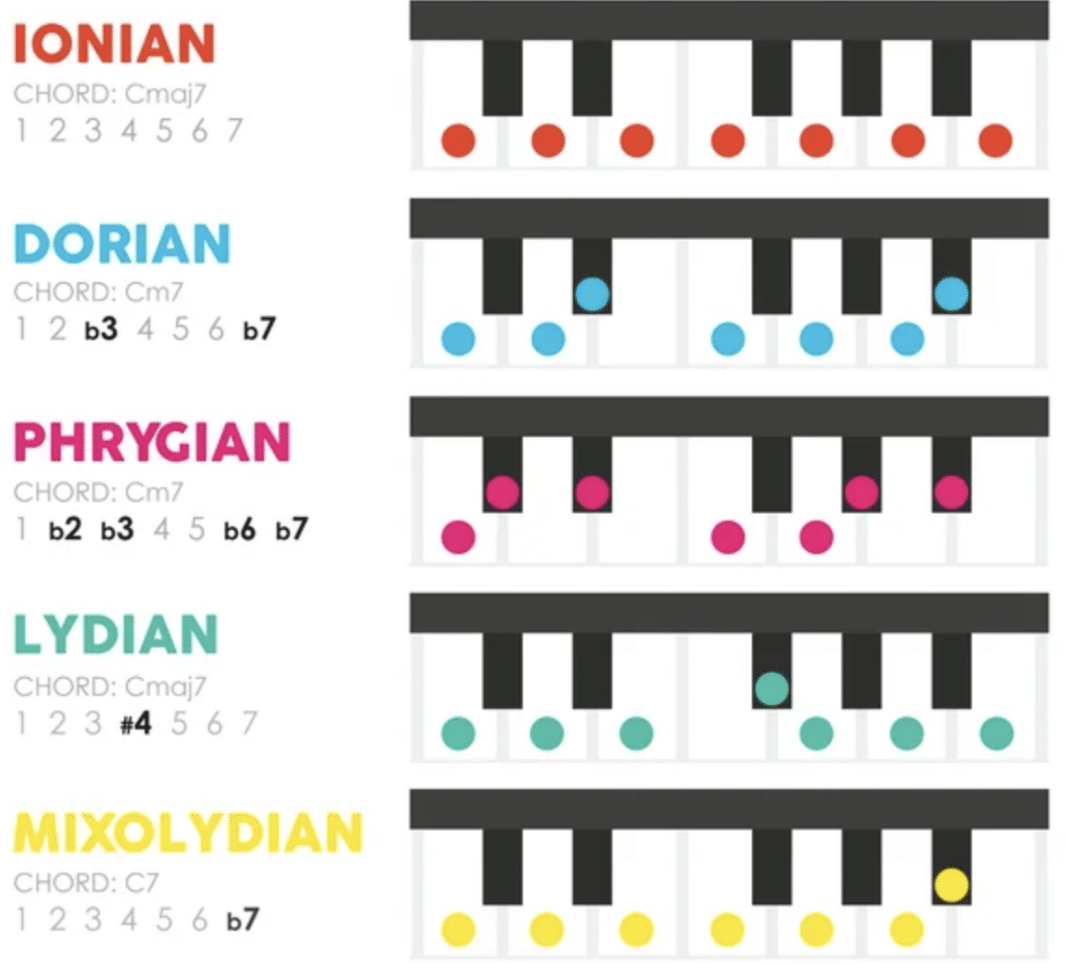
At its core, the major scale revolves around a specific formula of whole steps (W) and half steps (H): W-W-H-W-W-W-H.
This pattern provides the major scale with its distinctive sound 一 forming the basis of many melodies we recognize, love, and mesmerize.
For instance, the C major scale consists of the music notes:
- C
- D
- E
- F
- G
- A
- B
- Back to C
Following the above formula, the progression between these music notes follows the W-W-H-W-W-W-H sequence.
Knowing this sequence of whole and half-step intervals is crucial for crafting harmonically sound chord progressions that are unique and intriguing.
The major scale’s beauty lies in its adaptability.
One can derive different major scales and music modes by starting on different notes but adhering to the same W-W-H (whole step/half step) pattern.
For a hip-hop track that needs a sunny, uplifting vibe, the major scale is a go-to choice.
-
Major Scale Starting Tricks for Catchy Beats
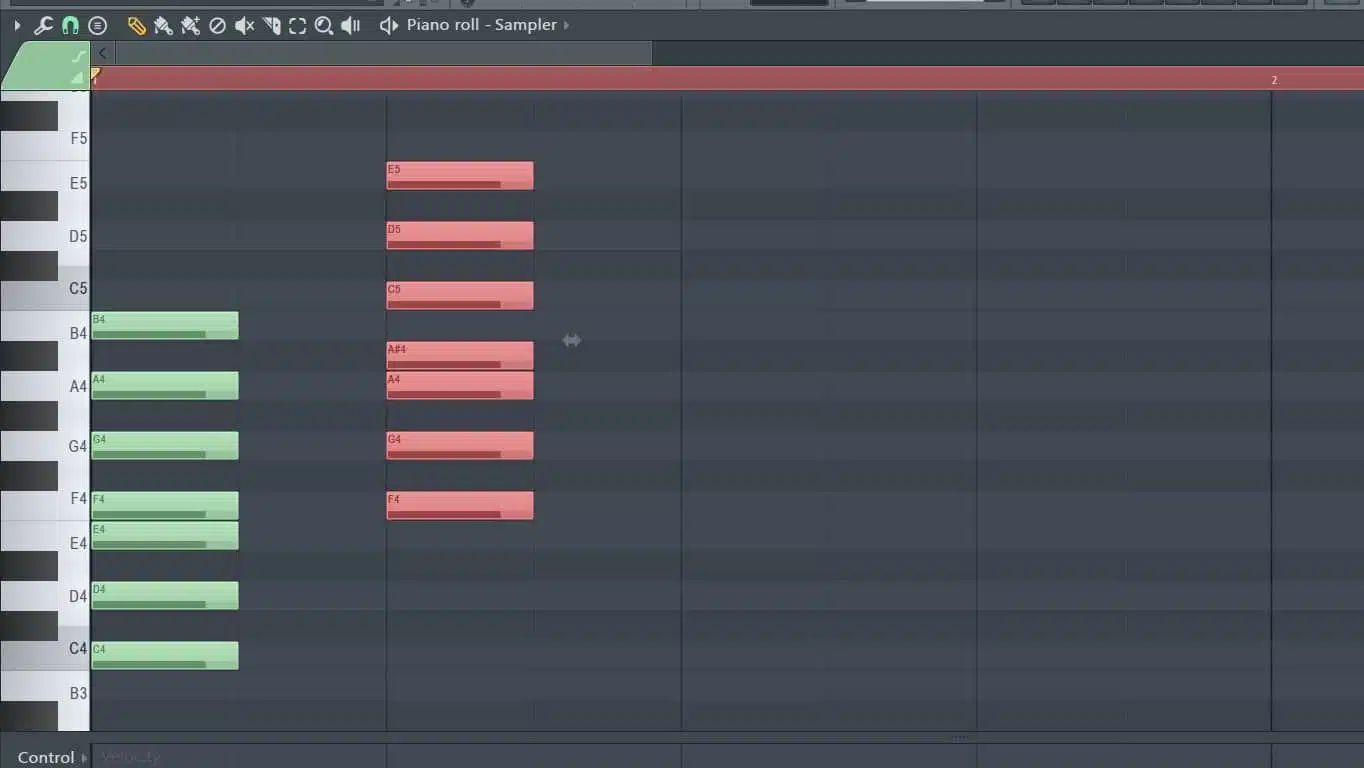
The beauty of the major scale is that its starting note, or “root note,” can shift to give a different tonal quality.
For instance, starting the major scale on D rather than C introduces a whole new palette of sounds while still staying within the familiar structure of the scale.
For trap producers, the major scale consists of very versatile and flexible elements.
Imagine producing a beat that requires a more somber or reflective tone…
Simply shifting the starting note of the major scale can provide the desired mood while retaining the scale’s inherent structure.
A technique often employed in the digital realm involves sampling.
You can sample a catchy section from an older track, pitch it up or down, and fit it into the major scale starting on a different note.
This provides a fresh twist to a familiar, nostalgic sound.
Additionally, leveraging tools like MIDI controllers becomes seamless when one understands the major scale’s structure.
By simply programming your MIDI controller to a specific major scale, you can experiment with melodies 一 confident that each note will harmonically align.
-
The Importance of Scale Notes in the C Major Scale
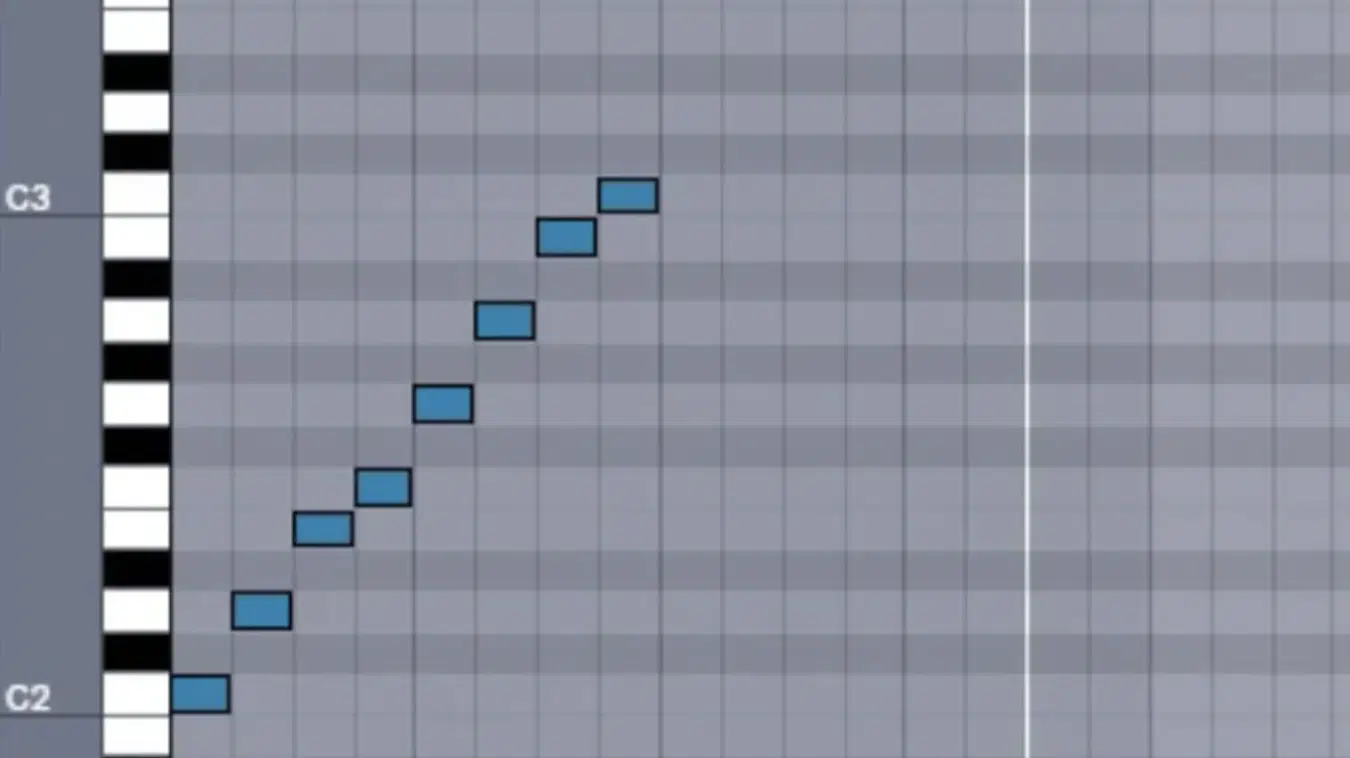
The C Major scale is perhaps the most accessible and commonly referenced scale, mainly due to its composition of all natural notes without any sharps or flats.
When exploring the C Major scale, you’ll find: C, D, E, F, G, A, and B.
Each of these notes has a significant role in establishing the mood and tonality of compositions.
NOTE: In hip-hop and trap genres, the C Major scale often serves as a starting point for melody creation.
Its notes can be used to easily craft catchy hooks or even to create a rhythmic backdrop for more complex tracks.
Familiarity with the precise tonal qualities of each note allows for more intentional musical choices; you’ll be able to match the vibe you want to convey with ease.
You can emphasize the note G (dominant) for its tension-building quality 一 leading to a musical resolution on the C (tonic).
Or, you might opt for E (mediant) to introduce a mellower, introspective touch to a track.
Knowing the significance of each note within the C Major scale is pivotal for nuanced music creation and can help your music contain that extra flair.
-
How the Major and Minor Scales Differ
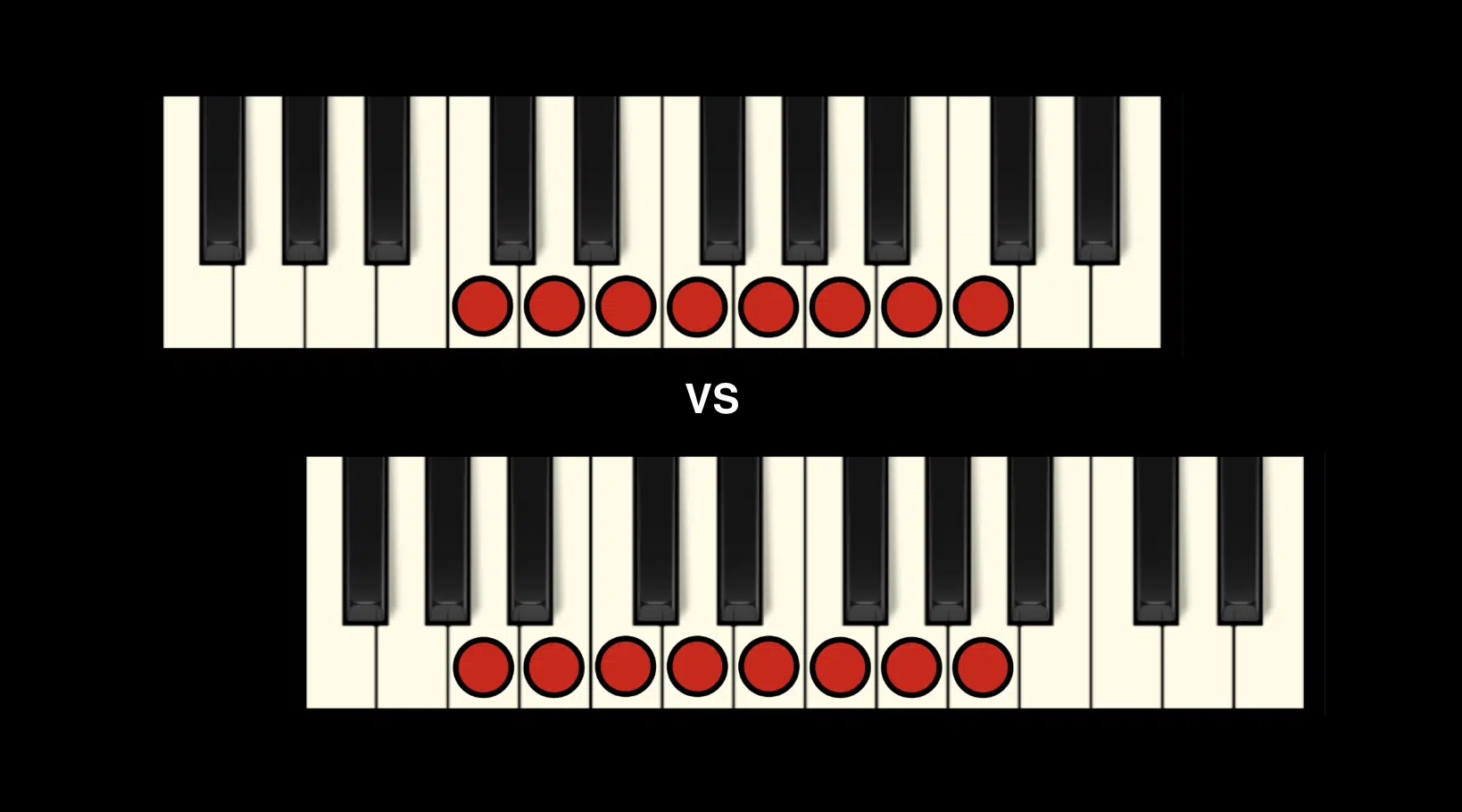
The distinction between major and minor scales is crucial for any music producer.
If you’re not familiar with the intrinsic factor of each, you won’t be able to properly convey your musical vision.
- Major scales 一 Contain uplifting, bright, and happy tonalities.
- Minor scales 一 Impart a somber, melancholic, or even mysterious vibe.
The primary difference between the major scale and minor scale lies in the third, sixth, and seventh notes of the scale.
In a minor scale, these notes are lowered by a half step compared to their counterparts in the major scale.
The A minor scale (the relative minor of C Major), the notes are A, B, C, D, E, F, and G.
Notice the absence of sharps or flats, yet a discernibly different mood from the C Major scale, which is important in understanding major scales and minor scales.
The decision between a major or minor scale can be the determining factor in the emotional impact of a track.
A trap song aiming for a darker, more introspective ambiance might lean towards minor scales 一 while one targeting an upbeat, club-friendly vibe might employ a major scale.
Understanding the relationship between relative major and minor scales can open up opportunities for modulation.
It allows you to shift between moods within a single track seamlessly.
Exploring the World of Minor Scales
Delving deeper, minor scales offer a vast palette of emotions and are pivotal in genres like hip-hop and trap where expressing deeper sentiments is essential.
-
Dive into the Natural Minor Scale
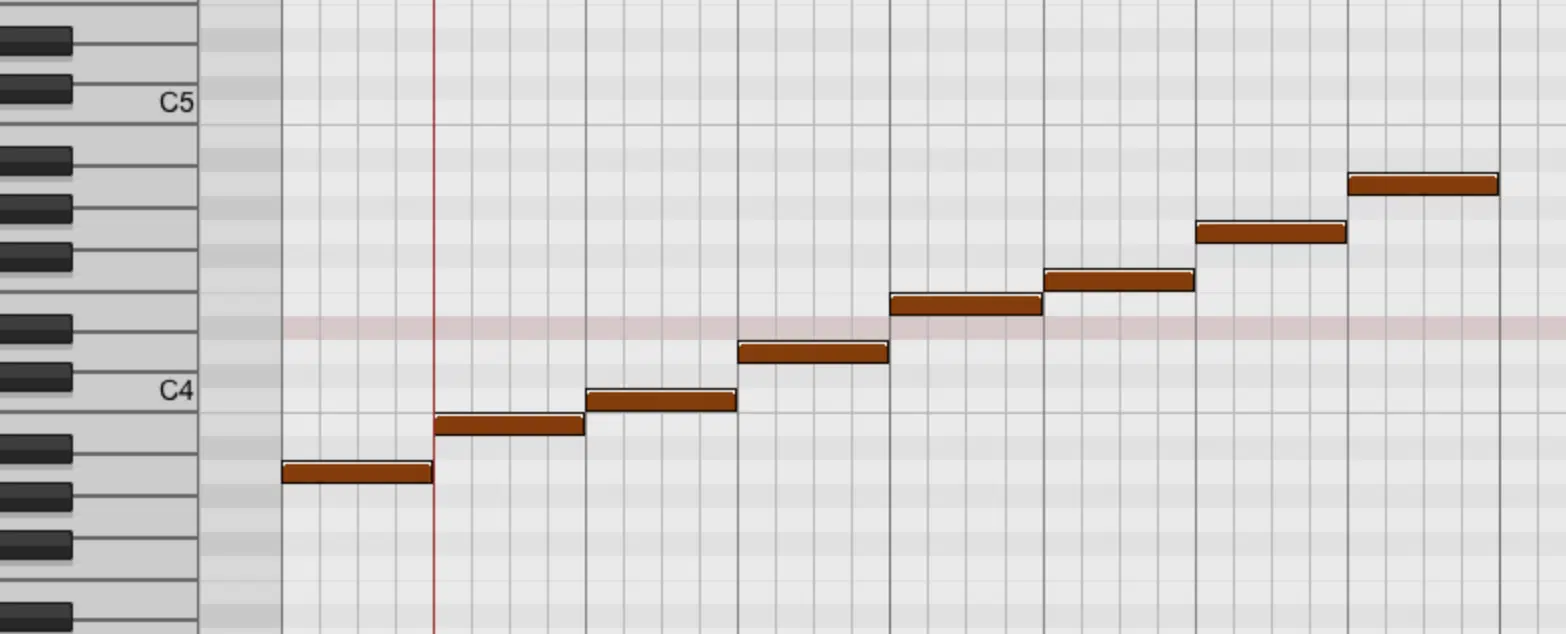
The natural minor scale, also known as the Aeolian mode, is the basic form of the minor scale.
Following a distinct pattern of whole and half steps: W-H-W-W-H-W-W, it offers a sound distinct from its major counterpart.
The natural minor scale serves as a foundational tool, especially when crafting tracks with a moody or introspective vibe.
The flattened third, sixth, and seventh notes of the natural minor scale introduces a sense of melancholy 一 making it apt for conveying deeper emotions.
In the digital production realm, using the natural minor scale can be as simple as choosing the right samples.
Or, as intricate as crafting layered harmonies that emphasize the music scale’s unique intervals; it’s all up to you and your creative intentions.
When it comes to using the natural minor scale, it’s all about a targeted balance and matching the vibe you want.
NOTE: If you’re looking for the most legendary advanced Aeolian Scales pack available, we’ve got you covered.
-
Harmonic Minor Scale vs. Melodic Minor Scale: What’s the Difference?
Beyond the natural minor lies the harmonic minor scale and melodic minor scale; each introducing its own set of intricacies.
#1. The Harmonic Minor Scale
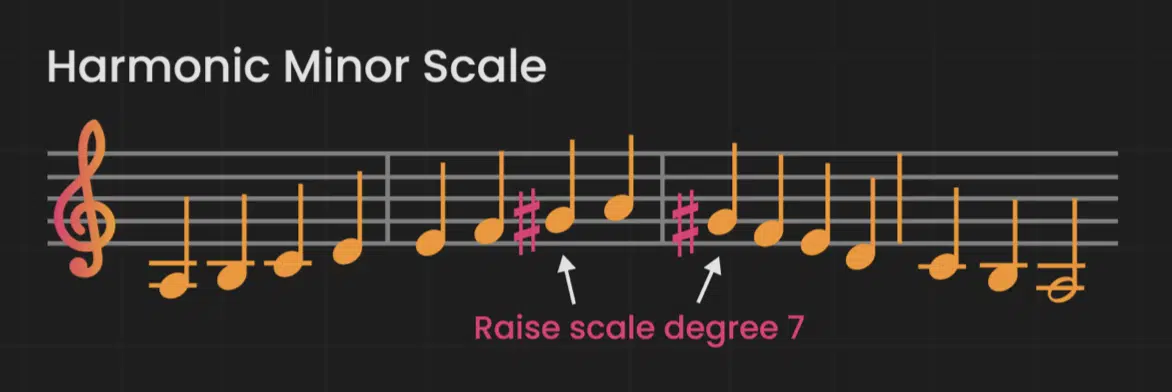
The harmonic minor scale is characterized by a raised seventh degree (note).
This gives the harmonic minor scale a distinct, almost “Eastern” sound, particularly between the sixth and seventh notes.
#2. The Melodic Minor Scale
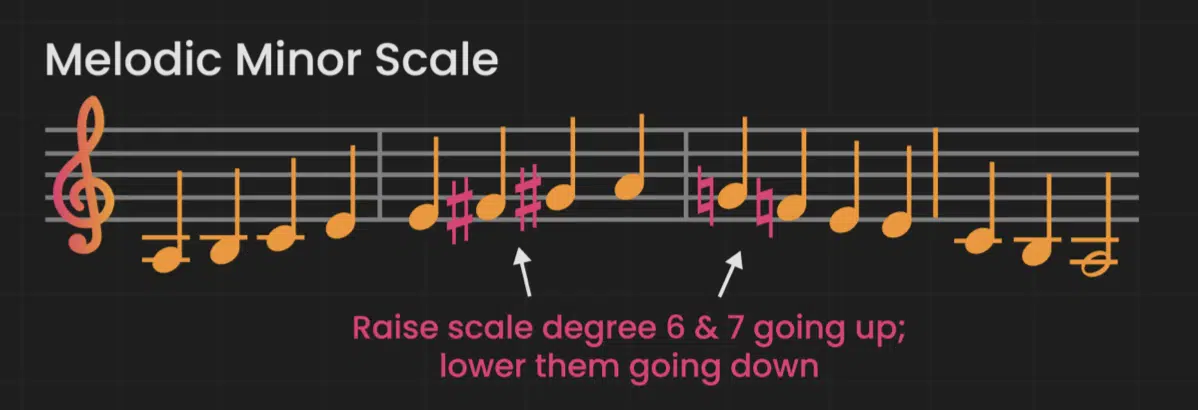
The melodic minor scale, on the other hand, raises both the sixth and seventh notes when ascending but reverts to the natural minor format when descending.
We’ll cover what a descending scale and ascending scale means later on in the article.
This dual nature offers a unique blend of sounds 一 allowing you more flexibility when you’re creating captivating melodies.
The harmonic minor scale and melodic minor scale can provide a twist to your tracks.
Imagine a trap beat employing the harmonic minor’s exotic interval jump, or a hip-hop track utilizing the melodic minor’s ascending brightness paired with descending melancholy.
Ultimately, understanding the harmonic minor scale and melodie minor scale can help you ensure your track remains innovative and emotionally resonant.
-
Using the Minor Pentatonic Scale for Those Moody Vibes
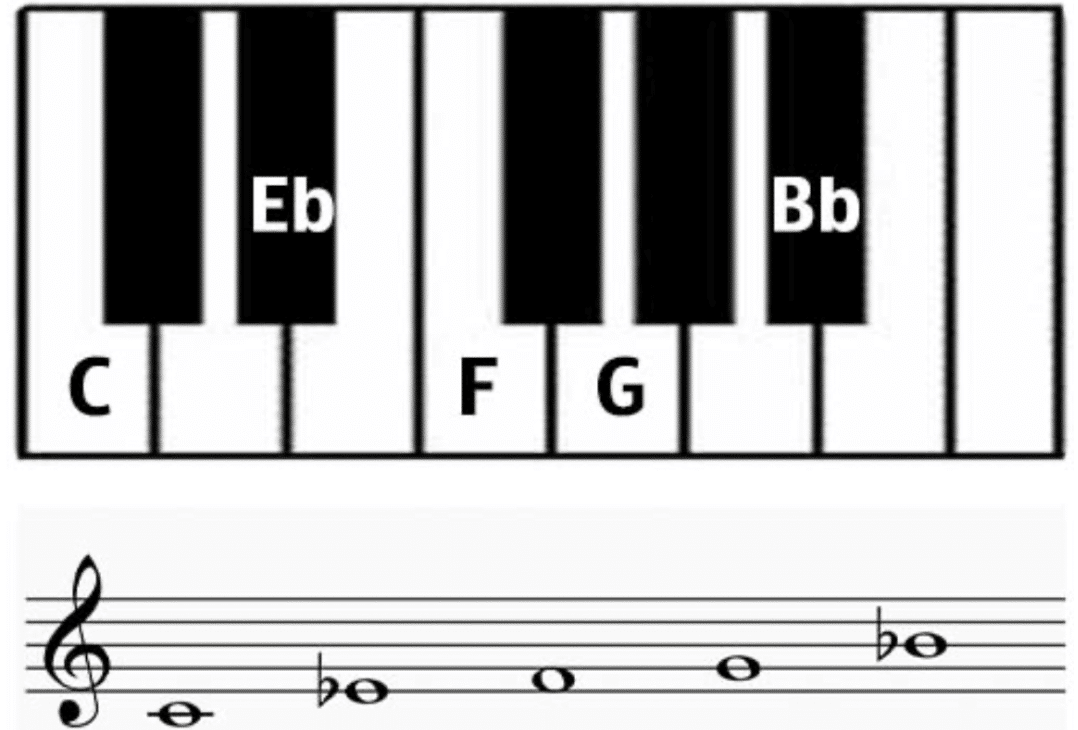
The C Minor Pentatonic Scale.
The minor pentatonic scale is a five-note scale derived from the natural minor scale.
This common scale leaves out the second and sixth degree 一 providing a “stripped down” and direct sonic quality that’s particularly effective for establishing a mood.
The minor pentatonic scale has been widely used for creating memorable riffs and super catchy hooks.
Given its streamlined nature, melodies built on the minor pentatonic scale often have a straightforward, catchy quality.
This makes them stick in listeners’ minds (and hearts) long after the song inevitably ends.
The sparse nature of the minor pentatonic scale also means less note clashes.
This is especially useful in genres like trap where the instrumental can be quite dense, and a clear, unambiguous melody can stand out effectively.
Examples in popular music abound, with numerous top-charting tracks leveraging the minor pentatonic’s moody vibes to craft unforgettable hooks.
Chromatic Scales: A Producer’s Wild Card
For those aiming to break free from traditional tonal constraints, the chromatic scale is like an open playground.
By understanding chromatic scales (both the ascending scale and descending scale variations) can help you create epic tracks.
So, let’s break it down.
-
The Ascending Chromatic Scale

For the ascending chromatic scale, use sharps (#).
The chromatic scale consists of twelve pitches 一 each a half step apart.
An ascending chromatic scale, therefore, is a continuous rise in half steps; providing a sense of tension and anticipation.
In digital production, an ascending chromatic scale run can serve as a dramatic build-up, leading to a drop or chorus.
Music scales like these provide a way to introduce tension in a controlled manner.
Remember to use the ascending chromatic scale in a calculated fashion; sprinkling in chromatic notes to add color or unpredictibilaty to a melody/bassline.
This will help your tracks remain engaging without being overwhelming.
Given its all-encompassing nature, the ascending chromatic scale can also be a tool for modulation.
It can provide a bridge between two seemingly unrelated keys or tonal centers.
-
The Descending Chromatic Scale

For the descending chromatic scale, use flats (b).
The descending chromatic scale offers a sense of resolution, grounding a piece after moments of tension.
When used effectively, it can evoke feelings of finality or descent into calm.
This descending scale can be especially useful in breakdown sections of a track or during outros to signal a slow down of energy.
It also prepares the listener for a conclusion or transition.
Furthermore, in hip-hop and trap, a descending chromatic line can introduce a sense of nostalgia or reflection 一 especially when paired with appropriate lyrical content.
From a technical perspective, music scales like this one, can create mind-blowing sonic textures when combined with innovative sound design.
Therefore, helping your track to have a more intriguing and captivating soundscape.
The Wonders of the Pentatonic Scales
Pentatonic scales, with their five-note structure, are foundational in many world cultures and remain relevant in modern genres.
Understanding the major pentatonic scale and minor pentatonic scale can elevate your tracks to new heights.
-
The Major Pentatonic Scale: A Staple in Trap Beats
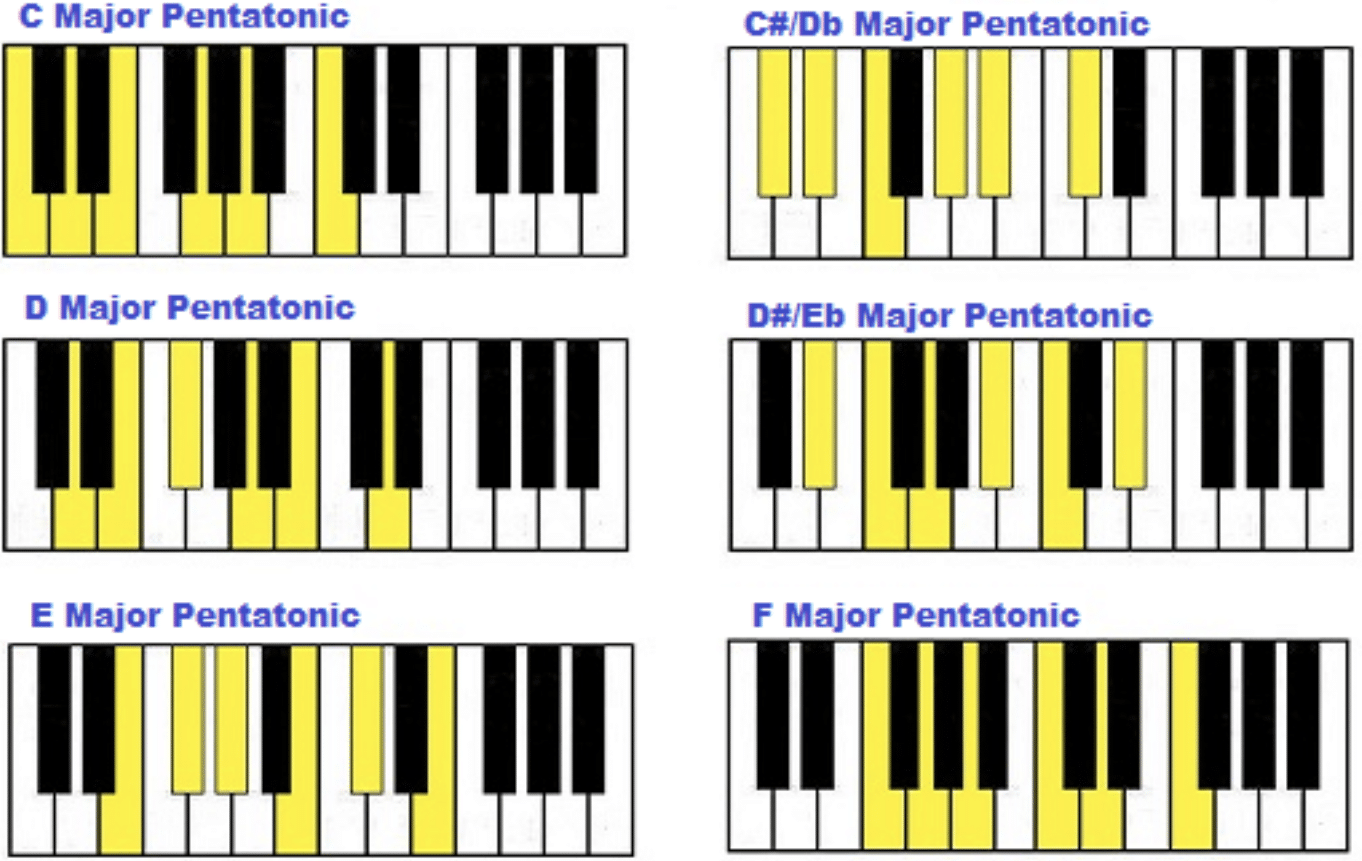
The major pentatonic scale, devoid of the fourth and seventh degrees of the major scale, offers a bright and uplifting tonality.
Its notes resonate well with listeners, which makes it a favored choice for creating memorable motifs.
In trap production, the major pentatonic scale often finds its place in creating positive, hopeful segments of tracks.
Its inherently consonant intervals make it perfect for crafting catchy hooks that resonate with audiences and get them hooked.
When compared to other music scales, the major pentatonic scale is used more often.
With its widespread use in western music, it provides a bridge that introduces folk music elements, lending it a particularly unique flavor.
Many hit trap songs employ the major pentatonic scale (either overtly or subtly), benefiting from its universal appeal.
-
Minor Pentatonic: The Go-to for Emotional Hooks
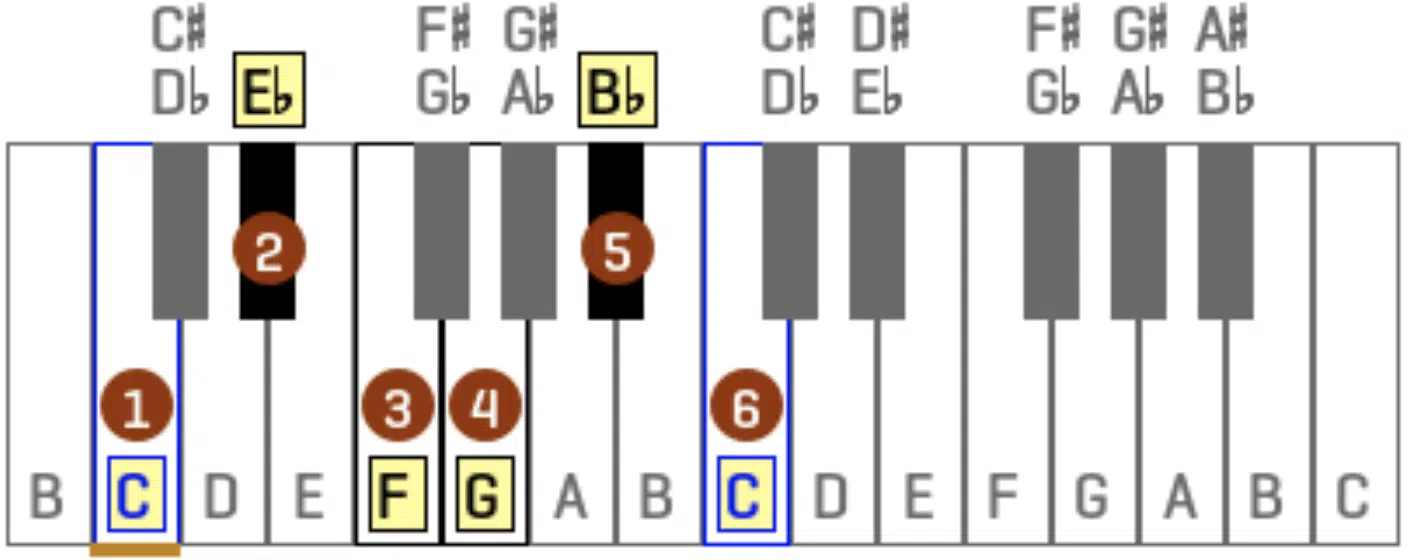
The C Minor Pentatonic Scale.
As discussed earlier, the minor pentatonic scale is a powerhouse for crafting emotionally charged melodies.
Its structure lends itself well to musical moments that need:
- Introspection
- A unique mood
- An aggressive moment
In hip-hop, the scale often underpins verses or hooks 一 delivering raw emotion and ensuring listener engagement.
It’s a music scale that speaks directly to the heart of any listener, and when combined with poignant lyrics, can create truly impactful music.
The minor pentatonic scale offers versatility.
Whether it’s a melancholic R&B-infused hip-hop track or an energetic trap anthem, this musical scale has the depth and breadth to cater to diverse moods.
The numerous classics in the hip-hop and trap canon that utilize the minor pentatonic are a testament to its enduring appeal.
-
Exploring the C Major Pentatonic Scale
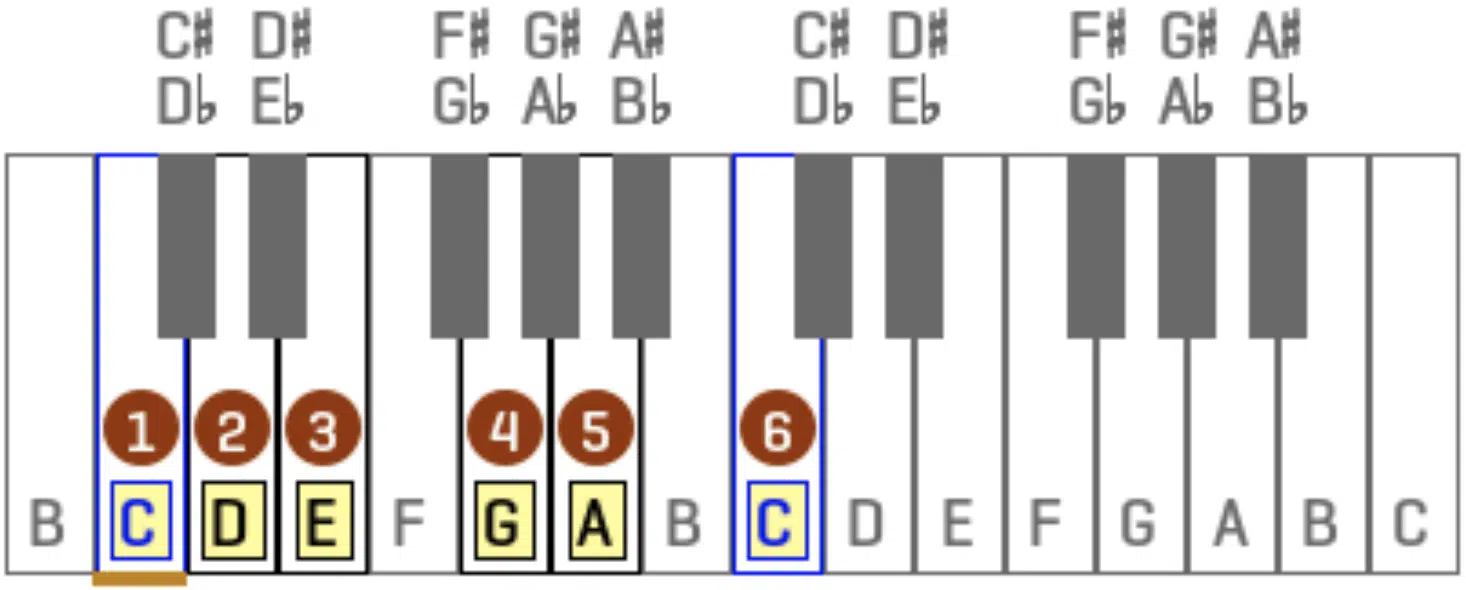
The C Major Pentatonic Scale.
The C Major Pentatonic Scale, consisting of the notes C, D, E, G, and A, is a go-to if you’re looking for a bright, clear sound.
Without the potential dissonance of a full major scale, of course.
Using the C Major pentatonic scale can help you craft melodies that have a universally pleasant tonality.
Given its simplicity, it’s also a favorite for creating repetitive motifs or ostinatos that form the backbone of a track.
NOTE: For those just venturing into the basics of music theory, the C Major Pentatonic serves as a fantastic starting point.
This music theory staple offers an easy framework and immediate results (in terms of harmonic consonance).
Whether it’s the basis for a full melody, an addition to a chord progression, or even a tool for improvisation, the C Major Pentatonic Scale holds significant value in the world of digital music production.
Speaking of Music Theory, if you’d like to know all the basics, we’ve got you covered.
Bonus: Expanding Horizons with Other Scales
Exploration beyond conventional music scales can lead to truly unique and distinctive sounds, providing you a fresh palette.
So, let’s break down some other scales so you have the freedom to be extra creative.
-
Whole Tone Scales & Their Dreamy Ambiance
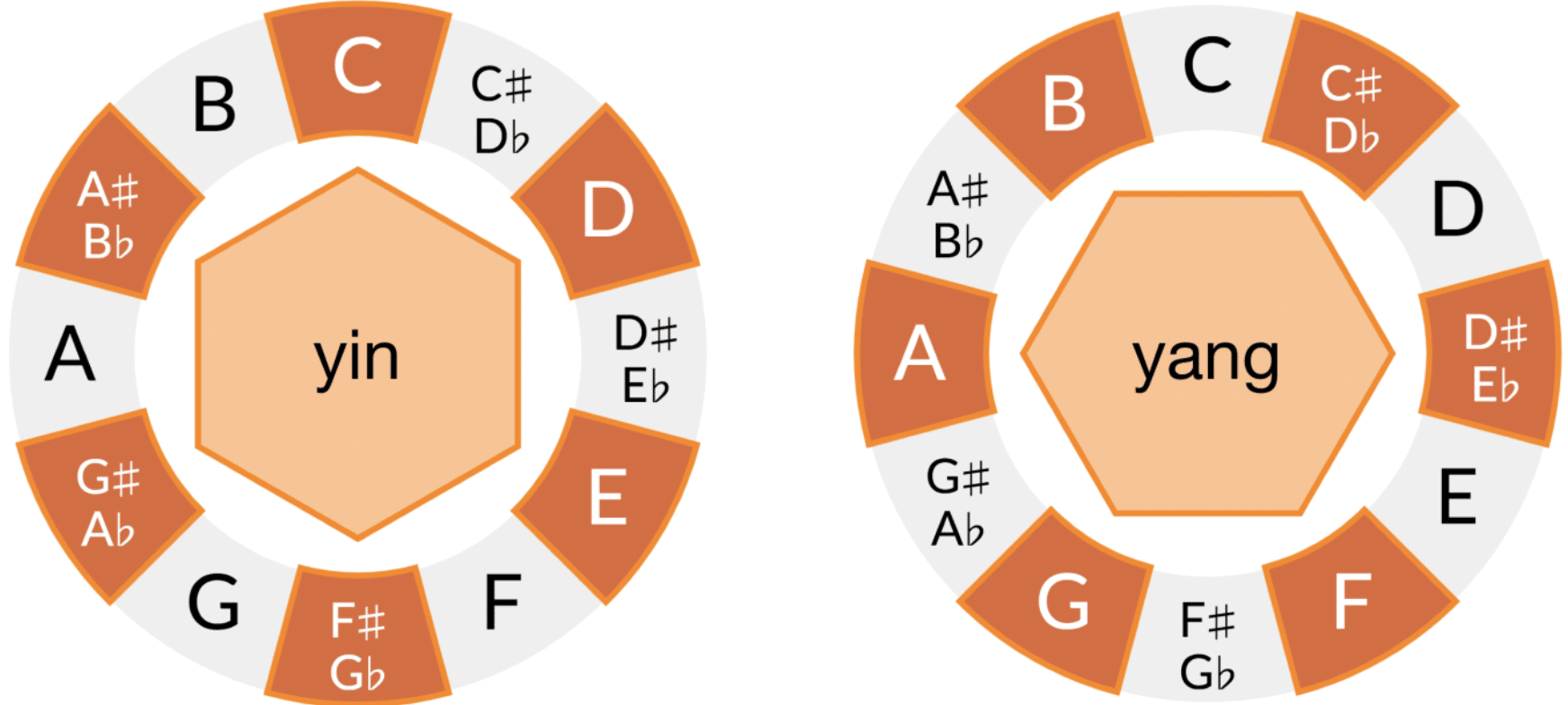
The whole tone scale, characterized by its series of whole steps, brings a dreamy, ethereal quality that’s hard to find in more common music scales.
Its lack of a leading tone (leading note) makes it feel without resolution, floating in space.
For producers dabbling in western music, the whole tone scale offers an opportunity to step outside of traditional tonalities.
This way, you can create a surreal, psychedelic texture to your tracks.
The whole tone scale has been historically used in film and television to evoke feelings of dream sequences or otherworldly events.
Therefore, integrating a whole tone scale can create an unexpected and engaging listening experience that your fans will crave.
The obscure nature of the whole tone scale can create alluring harmonies and melodies that feel open-ended.
Meaning, whole tone scales can impart suspense and adding a layer of intrigue to any composition.
-
The Blues Scale: Not Just for the Blues
Rooted deeply in African-American musical traditions, the blues scale is legendary.
The blues scale is a variant of the minor pentatonic scale, infused with the addition of a “blue” note, typically the diminished 5th.
NOTE: Diminished scales, unlike other tone scales, are symmetrical scales characterized by alternating whole and half steps, often used to evoke tension and drama.
While its origins are in the blues, this scale’s expressive nature has found its way into hip-hop and trap.
This is especially true in tracks that aim to evoke raw emotion or have a gritty texture.
The added “blue” note of the blues scale provides a touch of tension, which can be used to great effect to emphasize particular moments in a melody.
Or even to add depth to a groove; the possibilities are endless.
The powerful resonance of the blues scale makes it an essential tool for producers aiming for an authentic and emotionally charged sound.
If you’d like to uncover 11 powerful secrets behind diminished chords, we’ve divulged everything.
-
The Leading Tone and Its Magnetic Pull
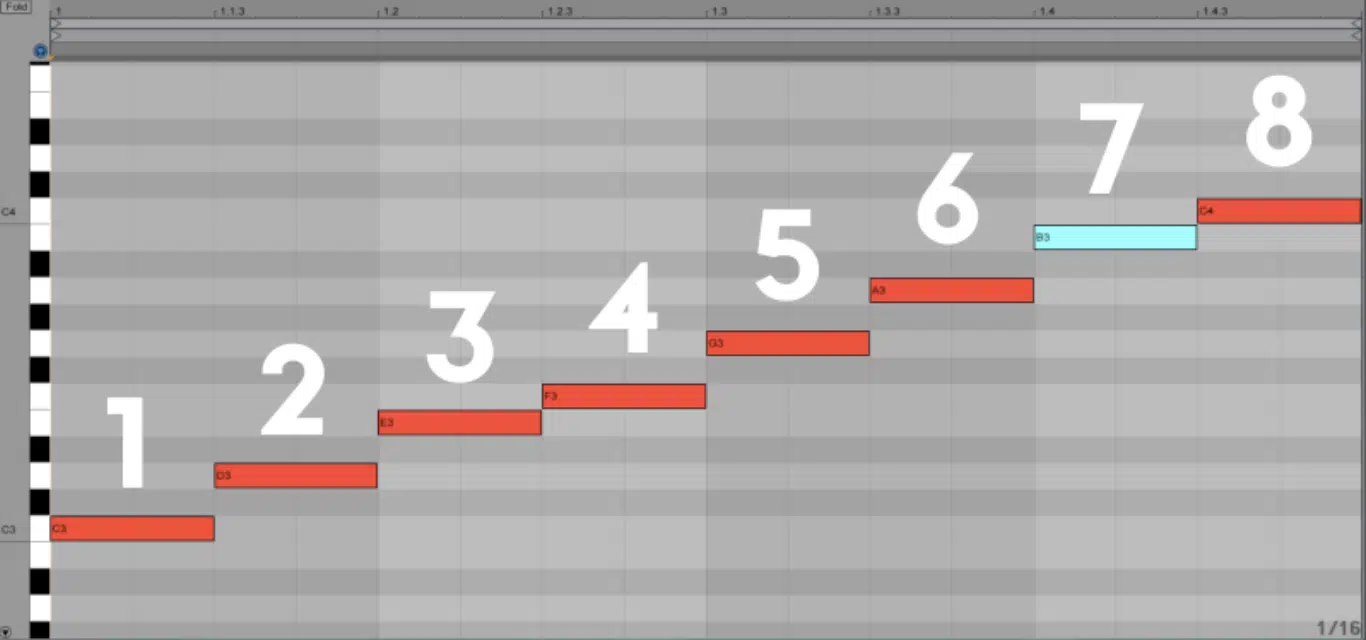
The leading tone, typically the seventh scale degree in a major scale, is a half step below the tonic.
It has a natural inclination to resolve upwards to the tonic, creating a feeling of closure.
In the world of hip-hop and trap, the leading tone can be used strategically to build tension and anticipation 一 especially leading into a chorus or drop.
The magnetic pull of the leading tone allows you to guide listeners’ emotions and expectations within a track.
Used judiciously, the leading tone can amplify the impact of key moments in a song, making them more memorable and resonant.
Music Scales: Final Thoughts
In the ever-evolving world of music production, the importance of understanding and effectively utilizing music scales cannot be overstated.
Music scales are the essence of melody creation, harmony structuring, and the soul of chord progressions.
They can be the differentiating factor between a generic track and a chart-topper.
Through music scales, a producer can journey through emotions, create compelling narratives, and forge connections with listeners.
For those who might feel overwhelmed with the intricacies of music scales, we’ve got your back with these free Advanced Scales MIDI Essentials.
This pack is not just about providing scales 一 it offers 24 advanced MIDI scales, melodies, and chord progressions that can instantly elevate your tracks.
With them, you’ll be able to produce tracks that not only captivate, but resonate with your audience on a deeper level.
They’re created by the world’s top music producers and sound designers, so the creative possibilities are endless.
As we’ve delved deep into the realm of music scales throughout this article, one thing remains clear: music scales are vital.
They’re the foundation upon which captivating compositions are built.
By integrating the knowledge of music scales you now have, you’ll be able to make music that exceeds your wildest expectations.
Don’t underestimate the power of music scales; embrace them, and watch your music soar to new heights.
Until next time…





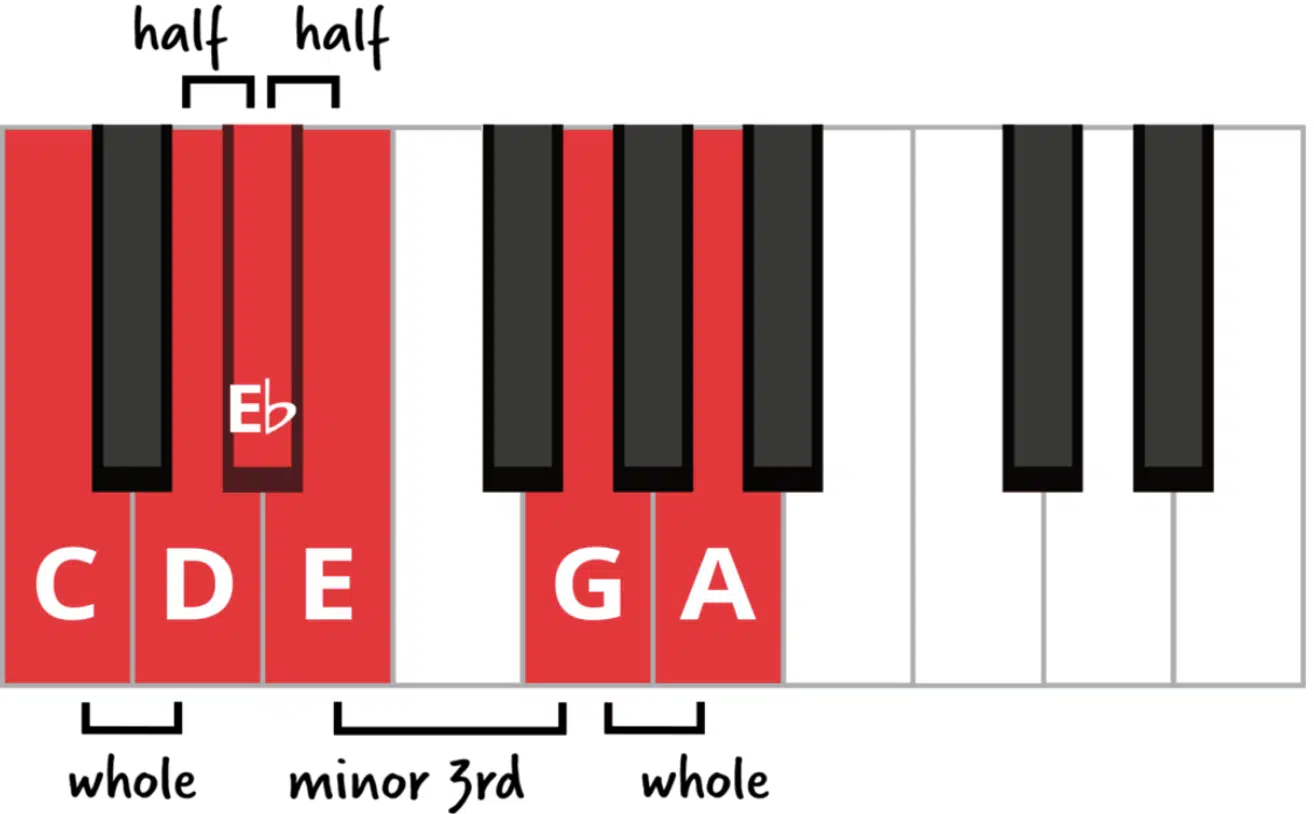


Leave a Reply
You must belogged in to post a comment.